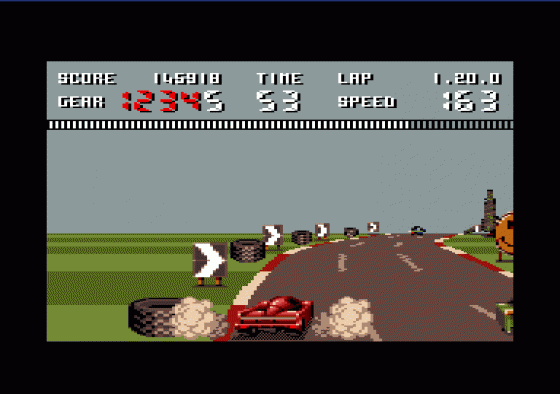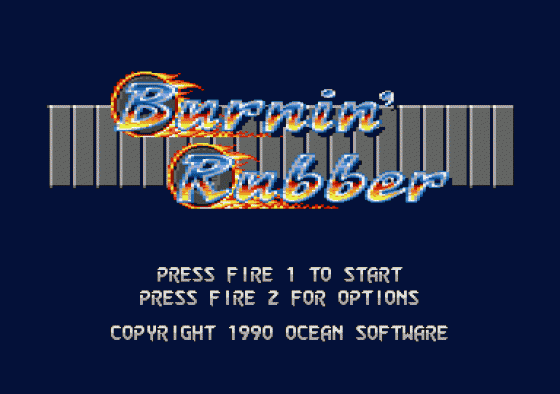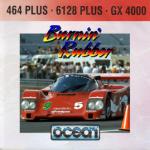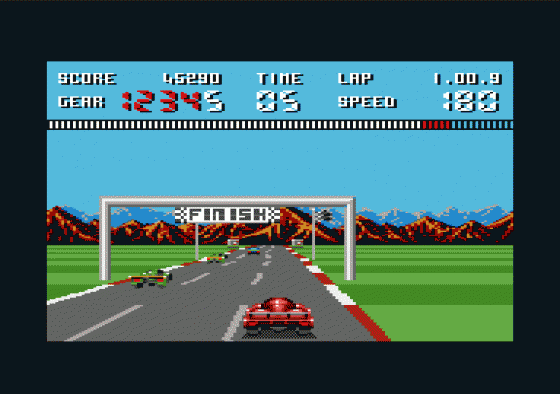
Amstrad Action
 1st September 1990
1st September 1990
Author: James Leach
Publisher: Ocean
Machine: Amstrad CPC464+/GX4000
Published in Amstrad Action #60
The first Amstrad cartridge game is here! Ocean's Burnin' Rubber comes free with the GX4000 console, the 464 Plus and the 6128 Plus.
And the verdict? It is absolutely stunning! For the full review, read on...
When you've finished admiring your new console and pretending it's something out of Stingray, you are ready to play Burnin' Rubber, the first ever Amstrad console game. Could this be the start of a new era of gaming?
First, big, wonderful difference: there's no sitting and looking at loading screens; plug in the cartridge and instantly you're there. All set? Then it's race time!
What you drive is a bright red Le Mans-style racing car, a machine capable of over 200mph in the right hands and the world's most expensive shunt in the wrong ones. Your job is to tackle a twisting race circuit and about twelve other cars. Be warned when you try to pass these, though; as in the real thing, not all sportsmen are sports.

First of all, though, you must qualify for the big race. This is done on a small circuit with right-hand bends only. The speeds are very high, and there are other cars on the track trying to qualify too. Still, if you keep your clog down and don't crash, you gain a place on the grid. Don't expect pole position first time round though. Spectacular slides and excursions onto the grass will lose you valuable split-seconds, while collisions with the scenery or other cars will either send you careering into a spin or cartwheeling down the track, depending on how fast you hit them.
Unless your name is Nigel Mansell, you will probably be buried in the middle of the pack on the starting grid after qualifying. No problem - there's a long, long race ahead. For all the cars you overtake on the way, though, there are always more ahead of you. Funny, that. Anyway, you must cast all such thoughts from your mind and concentrate as the lights change and you all screech off towards the mountains.
The other cars' initial acceleration is better than yours, so they remain in front, but once you hit a ton you start to overhaul them. The swines tend to hug the inside of the curves so you often have to overtake them whilst clinging desperately to the last few inches of tarmac on the outside of some ferocious bends.

A fair amount of bumping and shoving goes on between the cars, but it's best to avoid this since it loses you speed - you can even be knocked into a spin. And if you do decide to visit the surrounding scenery, your speed is reduced dramatically, as the car thrashes its way over the grass. There is a lot of roadside furniture, such as billboards, streetlamps, flag-poles and trees. Hitting any of these at great speed results in an incredible tumble end over end. You can drive away from these crashes, though - in fact the car can't be harmed at all, and never needs maintenance or fuel. (It's probably Japanese.)
Crashing may be safe, but the time it costs is crucial. You see, to stay in the race you have to reach special checkpoints situated every few miles within a tight time limit. Seconds remaining are displayed at the top of the screen, but don't spend too long staring or you'll end up cartwheeling through the scenery.
That's basically the aim of the game - to stay in the race as long as possible. It is possible to drive so well on earlier stages that you build up a reserve of time but one bad smash, and it's gone. And those time limits get tougher and tougher the longer you race.

Burnin' Rubber looks amazing. The increased number of colours on screen compared to the old CPC give apparently increased resolution and much more subtle shading. The cars are very detailed, especially your red machine. It looks mean from behind, but it's worth crashing or spinning out a few times just to see the side and front views!
The objects that flash past at the sides of the track are also superbly drawn. The almost obligatory Amstrad and Ocean ad hoardings are seen, along with many other interesting and graphically brill items. The 3D scrolling is smooth, too.
Perhaps the most spectacular thing about the graphics, though, are the changing colours. Your progress isn't measured solely by tightening time limits and escalating points. As the race goes on, it begins to get dark! Slowly, almost imperceptibly, the sky takes on a reddish tinge, the landscape darkens and twilight advances - just like the 24-hour Le Mans race, Burnin' Rubber goes on through the night! The colours are shown off beautifully when, during the race, dusk falls. A sunset of which Turner would be proud settles across the land as the cars move swiftly through the gloaming. The light fades gradually into a wonderfully atmospheric blue-black night.

As you race, you encounter hills, dips and tunnels. There are lights inside these tunnels to show you the way, but the walls are a lot harder than the grass verges outside, and you can lose precious seconds as your bodywork scrapes a shower of sparks from the concrete as you overcook a bend. Other hazards include crashed opponents sitting helpless in the road, or veering in front of you after striking each other glancing blows.
Once the basic controls have been mastered, the game becomes very playable indeed - if you don't like the standard controls, you can change them on an option screen right at the start of the game. Collision detection is good, perhaps slightly generous; your car can squeeze through gaps that will have you sucking in your breath. This adds to the fun, especially as the bumping and barging causes sparks to fly off the cars.
Roadholding is good, with the car sliding noisily towards the verge and giving you plenty of warning if you are going too fast. Skidding sounds are heard, and plumes of smoke spin off the tyres.

Unfortunately, the sound is not quite up to the same high standard. The option screen has a jolly tune playing. The car has a thin staccato sound which rises and falls with the revs. The skid noises are recognisable, but the crashes sound like a toy car being thrown down some stairs. The sounds do not really detract from the game, but they don't exactly add anything to it either.
And having to qualify before each race gets a little tedious, but you soon learn the best route to take and it's good to see your lap times improving.
Apart from the sound, the only quibble is the Sega-like hand controller. Confirmed joystick users will not be too impressed by its size and the initial vagueness of its direction control, but it gets better with practice. It's also possible to use a standard joystick with Burnin' Rubber, but since these only have one Fire button the car needs to be set up with automatic gears. So if you want to drive a real racing car, persevere with the paddle!
Overall, it's a hell of a start for the console. An incredible game to see and to play. And as the machine's capabilities are bound to be stretched even further in the future, we can look forward to some wicked, wicked games!






